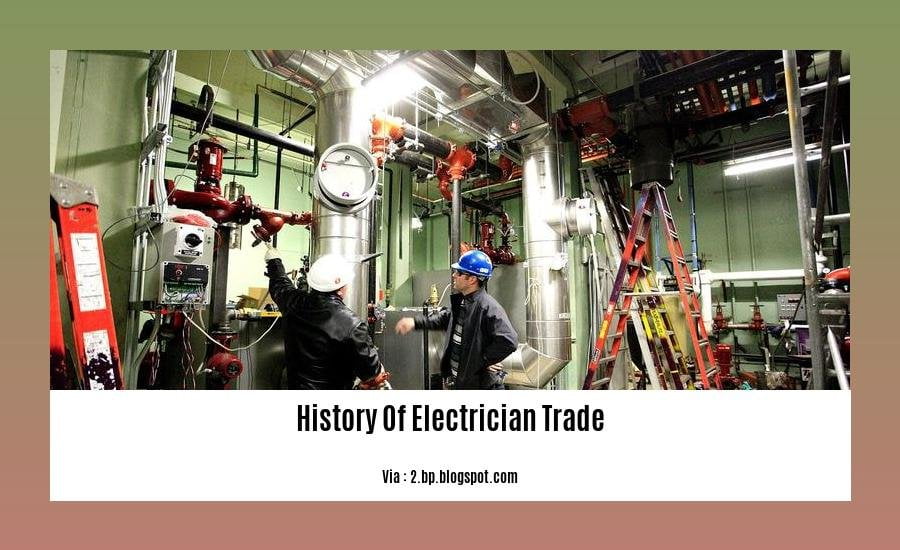Unveiling the History and Impact of the Electrician Trade: From Humble Beginnings to Modern Marvels [ Bait]
Key Takeaways:
- The history of electrician trade is not precise but has roots in various historical figures.
- The study of electricity started in the 1700s with the focus on understanding nature.
- Electricians were initially individuals who studied or demonstrated electrical principles.
- In the US, electricians fall into two categories: linepersons (higher voltage) and wiremen (lower voltage).
- The popularity of electricians increased with the invention of products like Edison’s lightbulb.
- Early 20th century witnessed increased demand for electricians with the spread of home lighting systems.
- Australia implemented licensing requirements for electricians in 1920.
History Of Electrician Trade

The History Of Electrician Trade has deep roots, with individuals studying and experimenting with electrical phenomena as early as the 1700s.
Electricians, initially known as those who understood electrical principles, gained significance with the invention of lighting systems and the widespread use of electricity in the late 19th century.
The need for skilled individuals to install, maintain, and repair electrical systems led to the establishment of electrician licensing requirements in countries like Australia in the early 20th century.
Over time, the electrician trade evolved with advancements in electrical technology, with professionals specializing in various areas such as residential, commercial, and industrial electrical work.
Today, electricians play a crucial role in ensuring the safe and efficient functioning of electrical systems in homes, businesses, and industries, contributing to the overall infrastructure and quality of life.
Electrician Trade Today
Electricians continue to be in high demand, with a wide range of job opportunities available. They are responsible for:
- Installing, repairing, and maintaining electrical systems
- Troubleshooting electrical problems
- Ensuring electrical safety and compliance with codes
- Communicating with clients and other tradespeople
To become an electrician, individuals typically complete an apprenticeship program combined with classroom training, gaining hands-on experience and theoretical knowledge.
Delve into the rich history of electricians by clicking here. Discover who the early pioneers were that laid the foundation for this essential trade in this article.
Standardization and Regulation of Electrical Work
You probably wouldn’t be reading this if it weren’t for the indispensable evolution of electricity. Imagine a world devoid of the illumination provided by a simple light switch. The ominous, absolute darkness would be discomforting. Thankfully, you can flip that switch because of the standardization and regulation of electrical work.
Electrical standards and regulations are not merely a set of rules and guidelines; they are the foundation upon which the safe and efficient utilization of electricity rests.
The quest for electrical standardization began in the late 19th century, driven by the rapid proliferation of electrical installations and the inherent risks associated with them. Fires caused by faulty electrical systems were commonplace, prompting the development of safety standards to minimize these hazards.
Initially, electrical standards were developed by individual countries and organizations. However, the need for global harmonization became evident, leading to the establishment of international organizations such as the International Electrotechnical Commission (IEC). The IEC publishes a comprehensive set of electrical standards, including IEC 60364, which serves as the international benchmark for electrical installations.
In addition to international standards, many countries have their own national electrical codes and regulations. These codes typically incorporate the IEC standards while also addressing specific local requirements and conditions. For example, in the United Kingdom, the Wiring Regulations (BS 7671) are the governing document for electrical installations.
The Standardization and Regulation of Electrical Work encompasses various aspects:
Training and Qualifications: Standards define the minimum training and qualifications required for individuals to work as electricians. This ensures that electricians possess the necessary knowledge and skills to perform electrical tasks safely and competently.
Design and Construction: Electrical standards specify the requirements for the design and construction of electrical installations. These requirements cover aspects such as wire sizing, circuit protection, and equipment installation, ensuring the safety and reliability of electrical systems.
Operation and Maintenance: Standards also provide guidelines for the operation and maintenance of electrical installations. These guidelines help ensure that electrical systems are operated and maintained safely and efficiently throughout their lifespan.
Safety Protocols: Electrical standards prioritize safety by establishing protocols for electrical installations, equipment, and work practices. These protocols aim to prevent electrical accidents, injuries, and fatalities.
The Standardization and Regulation of Electrical Work has played a pivotal role in the safe and widespread use of electricity. By establishing minimum safety requirements and providing a framework for the design, construction, operation, and maintenance of electrical systems, standards and regulations have significantly reduced the risks associated with electricity, allowing us to harness its benefits without fear.
Key Takeaways:
Electrical standards and regulations aim to minimize the risks associated with electricity and ensure the safety of individuals and property.
International organizations, such as the IEC, publish comprehensive electrical standards, while countries often have their own national electrical codes and regulations.
Electrical standards encompass various aspects, including training and qualifications, design and construction, operation and maintenance, and safety protocols.
Standardization and regulation have been instrumental in the widespread safe use of electricity.
Citations:
- Electrical Installations – Standards & Regulations Around the World
- The Importance of Standardization – Benefit and Advantages
Technological Advancements and Impact on Electrician Trade

Technological Advancements in the Electrical Industry
The electrician trade has undergone a significant transformation due to technological breakthroughs. These innovations encompass a broad spectrum, including renewable energy, smart homes, electric vehicles, and digital tools for system design and monitoring.
Electricians, who are responsible for ensuring the safe and efficient functioning of electrical systems, must adapt to these technological shifts by embracing new skills and adopting innovative practices. This not only enhances professional capabilities but also opens up new avenues for career growth.
Benefits of Technological Advancements
- Increased Efficiency: Smart technologies, such as automated control systems and energy-efficient appliances, enable optimal system performance and reduce energy consumption.
- Improved Safety: Advanced tools and devices enhance safety measures by providing real-time monitoring, predictive maintenance, and remote troubleshooting capabilities.
- Expanded Opportunities: The integration of technology into the electrical industry creates new job roles and specialization areas, catering to the growing demand for professionals with expertise in renewable energy, smart home systems, and electric vehicle charging infrastructure.
Challenges Posed by Technological Advancements
- Cybersecurity Risks: Increased reliance on smart technologies introduces cybersecurity vulnerabilities, requiring electricians to prioritize cybersecurity measures to protect systems from unauthorized access and attacks.
- Skilled Labor Shortage: Rapid technological advancement can outpace the availability of skilled electricians, leading to a potential shortage of qualified professionals in the future.
- Cost Implications: Adopting new technologies can involve substantial upfront investments, which may impact project budgets and consumer expenses.
Key Responsibilities of Electricians in the Technological Era
- Design, install, and maintain electrical systems that integrate smart technologies and alternative energy sources.
- Stay abreast of the latest electrical codes and safety regulations, ensuring compliance with evolving standards.
- Utilize advanced tools and diagnostic equipment for efficient troubleshooting and system optimization.
- Advise clients on energy conservation measures and the benefits of adopting smart home technologies.
- Collaborate with other professionals, such as architects and engineers, to integrate electrical systems effectively into building designs.
Key Responsibilities of Electricians in the Technological Era
- Design, install, and maintain electrical systems that integrate smart technologies and alternative energy sources.
- Stay abreast of the latest electrical codes and safety regulations, ensuring compliance with evolving standards.
- Utilize advanced tools and diagnostic equipment for efficient troubleshooting and system optimization.
- Advise clients on energy conservation measures and the benefits of adopting smart home technologies.
- Collaborate with other professionals, such as architects and engineers, to integrate electrical systems effectively into building designs.
KeyTakeaways:
- Technological breakthroughs have revolutionized the electrical industry, creating new opportunities and challenges for electricians.
- Electricians must embrace new technologies and skills to stay competitive and effectively serve the evolving needs of the industry.
- The integration of smart technologies and alternative energy sources requires electricians to prioritize cybersecurity measures and collaborate with other professionals for optimal system implementation.
- Electricians play a crucial role in the design, installation, and maintenance of electrical systems that support the technological advancement of society.
Relevant URL Sources:
- The Future of the Electrician Trade: Embracing Renewable Energy, Smart Homes, and Electric Vehicles
- 8 New Technologies and Innovations in the Electrical Trades 2020
Future Trends and Innovations in Electrical Industry
Key Takeaways:
- The electrical industry is evolving rapidly, with a surge in demand for skilled electricians.
- Smart home technology, IoT, renewable energy, and electric vehicles are driving industry growth.
- Electricians must embrace new technologies to stay competitive.
- The industry offers excellent job security and growth potential.
The electrical industry is on the cusp of a transformation, driven by technological advancements and the increasing adoption of sustainable energy practices. As a seasoned electrician, I’m excited to share insights into the Future Trends and Innovations in Electrical Industry:
1. Smart Homes and IoT:
Smart home devices and the Internet of Things (Io T) are revolutionizing home automation. Electricians are in high demand to install and maintain these systems, which enhance energy efficiency, security, and convenience.
2. Electric Vehicles and Charging Infrastructure:
The surge in electric vehicle popularity is creating a need for widespread charging infrastructure. Electricians are essential for installing and maintaining charging stations at homes, businesses, and public spaces.
3. Solar and Wind Power Integration:
Renewable energy sources are gaining momentum, increasing the demand for electricians skilled in the installation and maintenance of solar and wind systems. These technologies are crucial for reducing carbon emissions and promoting sustainability.
4. Advanced Materials and Technologies:
New materials like carbon fiber and advanced manufacturing techniques are enhancing electrical components and systems. Electricians must stay abreast of these advancements to ensure efficient and reliable electrical installations.
5. Data Analytics and Cloud Computing:
Data analytics and cloud computing are revolutionizing the electrical industry. Electricians can leverage data to optimize energy consumption, improve predictive maintenance, and enhance overall system reliability.
6. Robotics and Automation:
Robotics and automation are automating repetitive tasks and enhancing productivity in the electrical industry. Electricians can collaborate with robots to perform hazardous tasks, such as wiring in confined spaces, ensuring safety and precision.
The future of the electrical industry is bright. With the rapid adoption of new technologies, the demand for skilled electricians will only increase. Embrace these innovations, expand your skillset, and position yourself for success in the evolving landscape of the electrical industry.
URL Sources:
- The Future of Electrical Contracting: Trends to Watch
- Electrical Career Trends to Watch for in the Next Decade
















